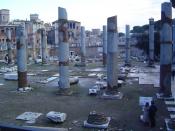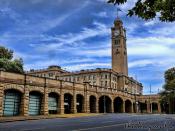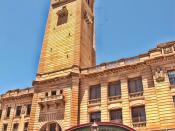Ambition and Architecture
Throughout history, man has built. Architecture, whether it is monumental or not, carries an important role in our society, not merely for functional purposes, but also as a means of communication. Eloquence without words, although difficult, is accomplished effectively through architecture because buildings often functions as a center, or at least a very important part, of life. Whether a building is religious or civic, it attracts, or rather demands, attention and is, therefore, a perfect medium for conveying a concrete and public message. In many cases, however, rulers who sponsor the building of structures are intent on portraying one idea: their own power and authority. Examples of architecture designed to convey the power and authority of a ruler are found throughout the history of art. Examples include The Forum of Trajan in Rome and the Mortuary Precinct of Zoser in Egypt. Both are vast architectural complexes built by powerful rulers and, although they serve different functional purposes, are used as a medium for establishing supremacy.
The Forum of Trajan and The Mortuary Precinct and Stepped Pyramid of Zoser are architectural complexes that were used to glorify their patrons (Emperor Trajan and Pharaoh Zoser, respectively). However, each complex exhibits a different approach towards this ultimate goal because the cultural differences between Romans and Egyptians made it necessary to use different techniques. Romans had pride in their community and civic identity while Egyptians placed a higher emphasis on the importance of the afterlife; as such, the architectural complexes reflect these ideas. I believe that the Forum of Trajan establishes power and authority by inviting the populous of Rome to marvel at Trajan's accomplishments while the Mortuary Precinct of Zoser establishes the power of the Pharaoh by exploiting the Egyptian beliefs in the importance of preparation for the afterlife.
The Forum of Trajan, designed by Apollodorus, was at the center of Roman life. The traditional forum of Rome served as a judiciary (basilica) as well as a center for other public business. It was, essentially, the gathering place for Rome. Because of the vast number of people that visited forums, it was important for an emperor to build one, so that all who attended could marvel at his power. The Forum of Trajan exhibits this concern for intimidation throughout.
The sheer grandness of the scale for the Forum of Trajan, as well as the references to Greek traditions in architecture, illustrates just how concerned Trajan was with outdoing former emperor's forums and, essentially, glorifying his own name. The Forum of Trajan was larger than the forums of Caesar, Augustus, and Nerva combined, and the Basilica Ulpia (named after his family) was, similarly, the largest of all basilicas in Rome; the two storied, dipteral basilica spanned a length of four hundred feet and was one hundred and fifty feet tall (Hartt, 259-260). Trabiated architecture, in the Greek tradition, was used throughout the forum. Particularly in the basilica, the post and lintel system, so favored by the Greeks in their temples, is used. Also, the ground level colonnade supported a massive frieze depicting Trajan's triumphal return to Rome after defeating the Dacians (the style of relief is similar to that of the Parthenon). Despite the fact that activity took place on the inside of the basilica, in contrast to Greek practice, the Basilica Ulpia, as well as the rest of the Forum of Trajan, still harkens back to Hellenistic traditions through the use of trabiated architecture and the frieze. The purpose of the Forum of Trajan is to glorify the power and authority of Trajan, and references to the Greek traditions in architecture are continually used throughout the forum because the Greek culture was revered by Romans. They were a great civilization, and, by quoting Greek traditions, Trajan associates himself with their supremacy and greatness. Through Alexander the Great, Greek culture influenced and ruled most of the known world, and, by making reference to Greek traditions, the power of its influence becomes a medium for portraying the power of Trajan.
The sculptural decoration of the Forum of Trajan portrays the emperor as a powerful conquer. In fact, the entire complex contains references to Trajan's successful military campaign against the Dacians. In the center of a grand colonnaded courtyard was a large, equestrian statue of Trajan, no doubt imposing, and around him in the plaza stood caryatid figures of bound Dacians. However, the most vivid example of how the Forum of Trajan made reference to the might and power of the emperor can be found on the Column of Trajan. The column stands behind the Basilica Ulpia in a court between two libraries. The base of the column contains more reference to military might: low relief carvings of weapons, but the column itself was decorated with a spiral relief illustrating the two campaigns against the Dacians. What is noteworthy is the attempt to convey the enemy as formidable rather than weak and easy to conquer. Therefore, it is Rome's superior preparation and skill, as well as the greatness of their commander (Trajan) that allows Rome to win the war. By portraying the Dacians as an admirable enemy, Trajan shows himself to be worthy of his position as emperor as well as a powerful military leader; his victory against the Dacians is shown to be a great feat that required skill, cunning, and power. Clearly, the Forum of Trajan uses the sculptural decoration to highlight the fact that the people of Rome are under a ruler who is powerful and worthy of praise.
Although the Forum of Trajan in Rome was used to advertise the power of the emperor because the public was always present, The Mortuary Precinct and Stepped Pyramid of Zoser could not show the Pharaoh's power in the same way because it was not a public gathering place. Monumental architecture in Ancient Egyptian times was not commissioned for the use of the people; rather it was commissioned for the use of the pharaoh and the priests in order to serve the gods. The Egyptian people placed great emphasis on the hereafter, and this is, similarly, reflected in their architecture. Because the life after death was considered to be of great importance, a Pharaoh established his power and authority on earth by building a great tomb to house his spirit (ka). The difference between the function of the Forum of Trajan and the Mortuary Precinct of Zoser accounts for the architectural differences between the two complexes.
Although the use of trabiated architecture, an axial plan, and the colonnaded court (similar to an Egyptian peristyle court) are incorporated into both complexes, the Forum of Trajan and the Mortuary Precinct of Zoser exhibit many differences. First, the accessibility of each varied dramatically because the forum was placed in the center of the city while the funerary complex was place outside the city. Also, while the Forum of Trajan was open to the public, the Funerary Precinct of Zoser was enclosed by a wall because entry was forbidden. Second, there was no reason to visit the Mortuary Precinct of Zoser (accept to pillage it) because, unlike the Roman forum, no public events or offices were housed in the complex. Along with a complex arrangement of temples and courtyards, buildings consisted of the stepped pyramid, which housed the deceased and his belongings, a serdab, which housed the image of the pharaoh, and various "dumby" buildings that contained rubble (used to fool robbers). Essentially, the Mortuary Precinct and Stepped Pyramid of Zoser was made to never be used by any living being.
Other differences are also evident between the two complexes. Roman buildings, including the Forum of Trajan, were made of concrete and brick that was faced with marble. This was done so that the buildings would look like Greek temples and give the illusion of permanence. Corinthian columns and narrative reliefs of events from the past decorate the complex, because Roman buildings were built to imitate, and expand, on Greek architectural principles. In contrast, the Mortuary Precinct and Stepped Pyramid of Zoser was made of quarried limestone. The stone used for columns and smaller buildings was cut to imitate past wooden temples and natural forms such as papyrus flowers and palm tree trunks, and the stone used for the stepped pyramid was cut into blocks. One of the most noticeable differences is that while the Basilica Ulpia reflects Greek influence, the Stepped Pyramid of Zoser exhibits some Mesopotamian influence. It is a man made mountain, a series of mastabas stacked on top of one another, which resembles a "staircase ascending to the heavens" (Hartt, 74)). In ancient times, the structure would have loomed in the distance, far from reach and forbidden to visit, but it was still an imposing and impressive structure that would have epitomized the power and authority of the Pharaoh.
The Mortuary temple and Stepped Pyramid of Zoser was a monument that established the Pharaoh's power and authority by exploiting Egyptian cultural beliefs in the importance of the after life. An impressive tomb, therefore, helped Zoser to ensure his status while he lived and reigned, as well as after he died. Using different techniques, Imhotep, the architect of this grand funerary complex, achieves the same imposing effect on the Egyptian people that the Forum of Trajan had on the people of Rome.
The grandness of the Funerary Complex of Zoser shows that, although it was not to be used by the people, it was to be seen and revered. The complex was very large; it was enclosed by a wall that was one thousand eight hundred feet long and nine hundred feet wide (Hartt, 74). The surrounding temples, courtyard, and serdab which housed the statue of Zoser only added to the sheer stateliness and solemnity of the complex. Most impressive of all the structures was the stepped pyramid. Rising high out of the desert sands and gleaming with golden-white limestone, the structure must have caused any who glimpsed it to stop and look (no doubt the purpose of its beauty and splendor). At its time, the complex was the largest funerary complex ever constructed which showed all of Zoser's subjects that he was the most powerful of all that had ever ruled before him. The solid and imposing forms of the Mortuary Precinct of Zoser convey a message of strength that no words could ever have done, and assured the Pharaoh praises fit for a god.
Although the grandness of the complex establishes a message of power, The Mortuary Precinct of Zoser conveys its message of power most potently through its references to nature and the past. Natural forms exist throughout the complex. Columns, particularly the capitals, are shaped to resemble flowers of the region, such as the papyrus. Also, the columns in the entrance hall, although engaged to the projecting wall, are fluted to resemble palm trees. Likewise, the complex references nature, as do all Egyptian buildings, through its orientation to the four corners of the compass. In doing this, it is related to the rising and setting of the sun and the north-south flow of the Nile. Also, elements of past wooden temples are transcribed into the stone structures of the complex. By referencing nature and the past, Zoser associates himself with the power and permanence of nature and the authority of the past.
By commissioning the building of such an impressive tomb, Zoser, most certainly, assures himself a comfortable and stable place in the afterlife. However, it is clear that this was not his only motivation for having this grand complex built. Egyptian culture was preoccupied with the idea of the afterlife, and erecting an impressive tomb was a sure way of advertising one's power and wealth. Also, by referencing nature and the past, Zoser associates himself with their permanence, authority, and stability.
The Forum of Trajan: a meeting place for the people and the Mortuary Complex and Stepped Pyramid of Zoser: a necropolis of a great king--although both were built for very different functions, they convey the same message. These are complexes that were built to advertise the power of their patrons. Although they were built thousands of years apart by different civilizations, they both exhibit the ambition of their rulers. The message is as clear in present times as it was when they were first built, and I believe this will be for many years to come.



Ambition and Architecture
Great paper!! Here are some tiny recommendations:
1. be sure to change spacing after sentences to two spaces.
2. Adjust opening statement/thesis statement to be a bit more specific - may help
1 out of 1 people found this comment useful.